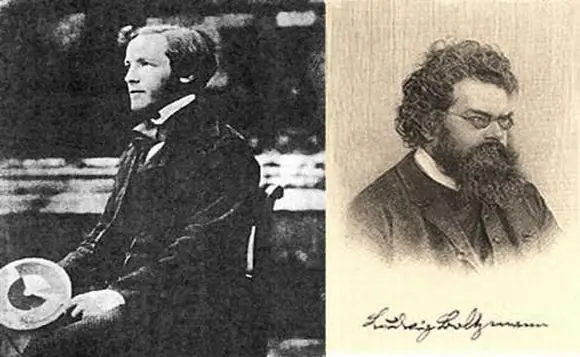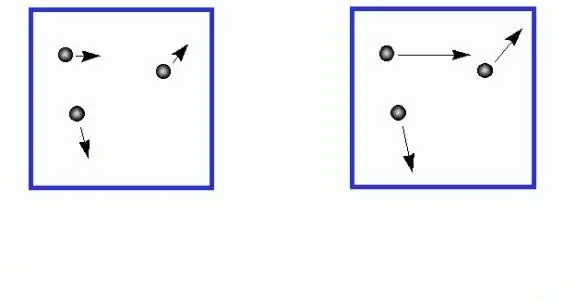Molecular-kinetic theory allows, by analyzing the microscopic behavior of the system and using the methods of statistical mechanics, to obtain important macroscopic characteristics of the thermodynamic system. One of the microscopic characteristics, which is related to the temperature of the system, is the mean square velocity of gas molecules. We give the formula for it and consider it in the article.
Ideal gas
We note right away that the formula for the quadratic average velocity of gas molecules will be given specifically for an ideal gas. Under it, in physics, such a many-particle system is considered in which particles (atoms, molecules) do not interact with each other (their kinetic energy is several orders of magnitude higher than the potential energy of interaction) and do not have dimensions, that is, they are points with a finite mass (the distance between particles several orders of magnitude greater than their size.linear).

Any gas that consists of chemically neutral molecules or atoms, and that is under low pressure and has a high temperature, can be considered ideal. For example, air is an ideal gas, but water vapor is no longer such (strong hydrogen bonds act between water molecules).
Molecular Kinetic Theory (MKT)

Studying an ideal gas within the MKT, you should pay attention to two important processes:
- Gas creates pressure by transferring to the walls of the vessel that contains it, the momentum when molecules and atoms collide with them. Such collisions are perfectly elastic.
- Molecules and atoms of gas move randomly in all directions with different speeds, the distribution of which is subject to Maxwell-Boltzmann statistics. The probability of collision between particles is extremely low, due to their negligible size and large distances between them.
Despite the fact that the individual velocities of gas particles differ greatly from each other, the average value of this value remains constant over time if there are no external influences on the system. The formula for the root-mean-square velocity of gas molecules can be obtained by considering the relationship between kinetic energy and temperature. We will deal with this issue in the next paragraph of the article.
Derivation of the formula for the quadratic average velocity of ideal gas molecules

Every student knows from the general course of physics that the kinetic energy of the translational motion of a body with mass m is calculated as follows:
Ek=mv2/2
Where v is the linear speed. On the other hand, the kinetic energy of a particle can also be determined in terms of the absolute temperature T, using the conversion factor kB(Boltzmann's constant). Since our space is three-dimensional, Ek is calculated as follows:
Ek=3/2kBT.
Equivalent to both equalities and expressing v from them, we obtain the formula for the average velocity of a quadratic ideal gas:
mv2/2=3/2kBT=>
v=√(3kBT/m).
In this formula, m - is the mass of the gas particle. Its value is inconvenient to use in practical calculations, since it is small (≈ 10-27kg). To avoid this inconvenience, let us recall the universal gas constant R and the molar mass M. The constant R with kB is related by the equality:
kB=R/NA.
The value of M is defined as follows:
M=mNA.
Taking into account both equalities, we obtain the following expression for the root-mean-square velocity of molecules:
v=√(3RT/M).
Thus, the mean square velocity of gas particles is directly proportional to the square root of absolute temperature and inversely proportional to the square root of molar mass.
Example of problem solving
Everyone knows that the air we breathe is 99% nitrogen and oxygen. It is necessary to determine the differences in the average velocities of the molecules N2 and O2 at a temperature of 15 oC.

This problem will be solved sequentially. First, we translate the temperature into absolute units, we have:
T=273, 15 + 15=288, 15 K.
Now write out the molar masses for each molecule under consideration:
MN2=0.028 kg/mol;
MO2=0.032 kg/mol.
Since the values of molar masses differ slightly, their average speeds at the same temperature should also be close. Using the formula for v, we obtain the following values for nitrogen and oxygen molecules:
v (N2)=√(38, 314288, 15/0, 028)=506.6 m/s;
v (O2)=√(38, 314288, 15/0, 032)=473.9 m/s.
Because nitrogen molecules are slightly lighter than oxygen molecules, they move faster. Average speed difference is:
v (N2) - v (O2)=506.6 - 473.9=32.7 m/ s.
The resulting value is only 6.5% of the average speed of nitrogen molecules. We draw attention to the high velocities of molecules in gases, even at low temperatures.






